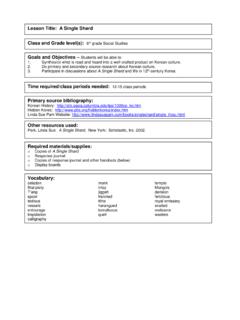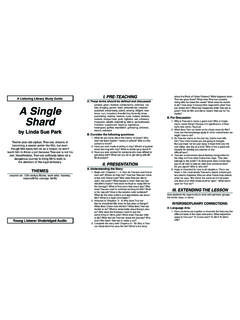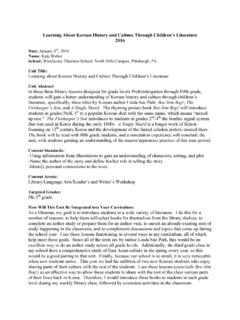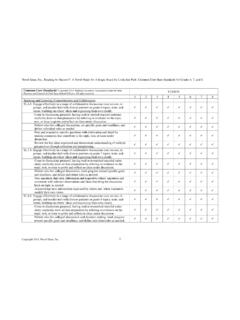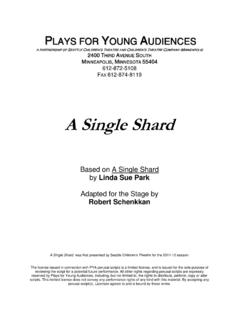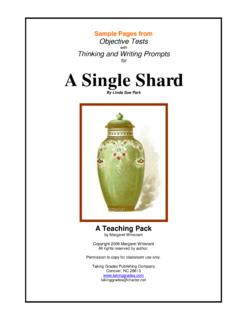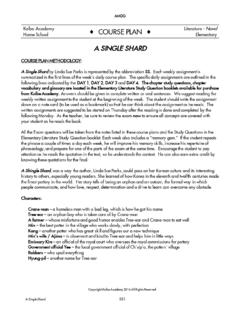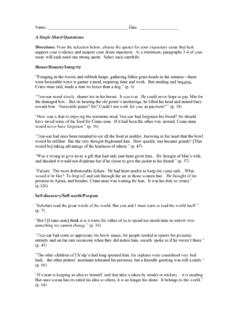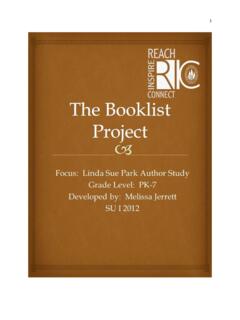Transcription of A Single Shard - blogs.tip.duke.edu
1 Duke TIP Book Club 1 A Single Shard by Linda Sue Park His home under the bridge outside the village of Ch ulp o is the only one he has ever known, and Tree-ear considers himself lucky to have it. After all, he was a nameless, homeless toddler when Crane-man took him in ten years ago. Since then, Crane-man has taught him to forage for food, keep warm, and savor the simple joys their limited way of life offers. Together, they make the best of what they have. Besides, neither has anywhere else to go. Crane-man is disabled, and Tree-ear is an orphan. In 12th century Korean society, both are destined to be outsiders. Although he accepted his fate long ago, Tree-ear s imagination has grown restless. Whenever he has a moment to spare, he heads to Potter Min s house. From his hiding place in the woods, he studies the master potter s technique at the throwing wheel or sneaks a closer look at his newest pieces. Watching him transform misshapen lumps of clay into such exquisite vessels flawless in symmetry, shape, and color makes Tree-ear s heart soar!
2 If only he had the chance, could he learn to do the same? One fateful day, Tree-ear is so busy day dreaming that he gets caught trespassing in Potter Min s yard. As punishment, Tree-ear finds himself doing the reclusive potter s chores and spending less and less time with Crane-man, especially once the villagers hear the royal emissary for pottery ware is on his way to Ch ulp o. Will Tree-ear s assistance enable Potter Min to earn the highest honor, a royal commission? Will the master potter defy tradition and give an orphaned boy the chance to become his apprentice? Will Tree-ear leave Crane-man behind? About the Author Since she was very small, reading has always been Linda Sue Park s top favorite thing to do, and believe it or not, she became a published author herself at the age of nine! Seeing one of her poems printed in a children s magazine inspired Park to continue writing stories and poems throughout her childhood, and her parents encouraged her efforts.
3 Her love of books even led her to study English literature in college. Park tried out several different jobs (such as public relations writer, food journalist, and teacher) before settling into a career writing children s books. As the daughter of Korean immigrants, she is dedicated to helping young readers make positive, meaningful cross-cultural connections, particularly between America and Asia. Park has won numerous awards for both picture and chapter books, including the 2002 Newberry award for her novel A Single Shard . She has also contributed two novels to a popular collaborative writing project with which you may already be familiar: The 39 Clues. To learn more about Linda Sue Park, especially the books she thinks every kid should read, visit her personal Web site. Getting Started You can find A Single Shard at your local or school library, or at local or online bookstores. It s also available as an ebook for your iPad, Kindle, or Nook.
4 Duke TIP Book Club 2 While You re Reading Every good story is full of captivating characters, timeless and timely themes, significant settings, pivotal plot points, and vivid vocabulary that combine to engage our brains and our hearts. In this section of the website, you will find activities that invite you to dig deeper into each of these literary elements for a better understanding and enjoyment of the book. To aid your investigation, save our Writing While You Read guide (see pages 22 and 23), with helpful tips on keeping a reading journal and annotating a book while you read. Respond to the following prompts in your Reading Journal as you read (or re-read!) Chapters 1-4 of A Single Shard : The key way a writer helps his or her readers connect with a story is through its characters. Which qualities, behaviors, and choices do you think make some characters more appealing than others? To help you answer this question with specific evidence from the book, use the Character Grid you ll find on pages 24 and 25 below (and you can make extra copies of page 25 if you need them).
5 Tuck it inside your book, and, each time you meet a new character, take a minute to jot down the name and your initial observations about him or her on your Character Grid. Be sure to revisit your Grid every few chapters or so, too! There may be more ideas you want to add as you get to know each character better. When we first meet Tree-ear, he has just arrived home with his pouch full of rice (5). What does his encounter with the farmer tell you about Tree-ear s character? What kind of boy is he? Describe Tree-ear and Crane-man s home under the bridge. What are the prominent features, sights, sounds, textures, and smells? How do you think growing up in this setting has affected Tree-ear? Based on what you know of their situation, do you think Tree-ear and Crane-man are outsiders in Ch ulp o by choice or necessity? Why? What alternatives for food, shelter, and occupation do they have? Both Tree-ear and Crane-man have unusual, nature-based names (7).
6 How did they get these names? How do their names compare with others in the community? In this culture, how might one s name be a reflection of his or her place, or value, in society? Obviously, securing enough food is a prime concern for Tree-ear and Crane-man on a daily basis. They are willing to rummage for scraps in the village rubbish heaps, eat plants that most people consider weeds (27), and scour harvested fields for overlooked grains of rice. According to Crane-man, these [are] honorable ways to garner a meal, requiring time and work. But stealing and begging .. [make] a man no better than a dog. Work gives a man dignity, stealing takes it away (6). Crane-man and Tree-ear would rather go to bed hungry than act dishonorably. How do you think Duke TIP Book Club 3 these two characters maintain such a positive outlook despite the many challenges they face in life? Why do they cling to their sense of honor even though they have so little?
7 Crane-man has obviously taught Tree-ear to be mindful of proper etiquette. Tree-ear is careful to keep his eyes cast downward respectfully whenever Potter Min or his wife is speaking to him (25, 30). He bows humbly when greeting or thanking others (28, 31). He bows with palms raised when receiving a gift (34). Because he is a homeless orphan, Tree-ear must be doubly certain that his words and behavior never cause offense, particularly to his elders. When Min catches him trespassing in his yard and accuses him of stealing, however, Tree-ear cannot resist [raising] his head and [looking] at Min. He [keeps] his voice respectful, but his words [are] proud (17). Much to Min s surprise, Tree-ear stands up for himself: I would not steal. Stealing and begging make a man no better than a dog (17). Why does this bold reply change Min s mind about Tree-ear? How might this confrontation have ended differently if Tree-ear had remained silent?
8 In what way(s) does Crane-man s withered leg affect his day-to-day activities? What special skills and abilities has he cultivated despite his disability? In what way(s) is he an artist himself? Be sure to include specific examples from the text for support. Respond to the following prompts in your Reading Journal as you read (or re-read!) Chapters 5-9 of A Single Shard : Works of historical fiction, like A Single Shard , bring people and events from the past to life and help us understand the human experience in a more meaningful way than textbooks can do. Based on what you have read so far, what observations can you make about the homes, clothing, food, religion, traditions, and customs of 12th century Korea? How do these cultural elements influence the way Tree-ear lives, thinks, and interacts with others on a daily basis? How does Tree-ear s culture compare with your own today? Try creating a Venn diagram (see pages 26 and 27) to help you visualize the similarities and differences.
9 Think about the ways in which a typical young person s life has changed over the last nine-hundred years or so. Describe Potter Min s creative process. Is throwing pots merely a job for him, or is it something more? How do his completed pieces and reputation compare to other potters in the village? Consider how Min s approach to his work compares to your own. How does your own approach differ depending on whether you ve been assigned the work or chosen it for yourself? In some ways, it is surprising that a boy like Tree-ear would even be interested in pottery making. After all, he has spent most of his life living under a bridge and rummaging through rubbish heaps. Nevertheless, he agrees to work for Potter Min without pay (30). He perseveres despite injuring himself many times chopping wood and digging clay (21, 31). He withstands Min s vague instructions, harsh mood swings, and scolding (42). To Tree-ear, learning to throw a pot is more than worth all of this frustration.
10 Despite his poverty, he dreams in vivid Duke TIP Book Club 4 detail of the prunus vase he hopes to create someday: It [will] be .. the most elegant of all the shapes. Tall and beautifully proportioned, rising from its base to flare gracefully and then round to the mouth (52). The contrast between Tree-ear s living conditions and his artistic vision is striking. Who or what inspires him? As the book progresses, what gifts or abilities do you see Tree-ear discovering and cultivating in hopes that his dream will soon become a reality? Consider the way Potter Min supervises Tree-ear. Day after day, [T]he potter [barks] terse commands, which Tree-ear [struggles] to satisfy by whatever means [are] available to him watching Min, watching other potters, experimenting. He [does] not know why Min [does] not explain things more fully; Tree-ear s mistakes often cost valuable time or [waste] valuable clay (42). Why do you think Min doesn t take the time to show Tree-ear what to do?
